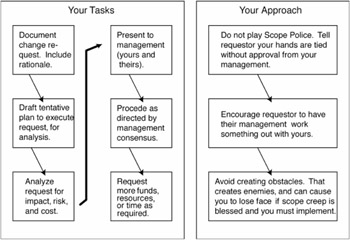13.10 Reacting to Scope Creep
|
| < Day Day Up > |
|
13.10 Reacting to Scope Creep
Whether you use these tips from the experienced project manager or Tarot cards, once scope creep is detected, you must react quickly. Those planning sessions I described earlier, which emerged from an initial beneficiary objection, are like planning your own execution. The further you get into those discussions, the harder it is to extricate yourself from them without incurring beneficiary wrath. The psychology of scope creep is pretty interesting. Once you cross the line of information exchange between the project office and beneficiaries to discussions regarding how to change the project to mitigate their risk, beneficiaries generally infer from this your acquiescence to accept their problems as yours to fix. It is admittedly hard to say no, but you must do something once you recognize you are getting stampeded into changing your plans significantly to suit your beneficiaries.
What to do? As previously discussed, these discussions should be carefully documented. As a salesperson, I was taught, from the moment an objection is raised, to echo it back to the beneficiary in my own words and haggle, if necessary, over the words until both sides are comfortable that the issue has been properly articulated. In the project context, you would likely engage operations or technologists on both teams to further explore the issue, possibly even to the degree of crafting a solution.
During this process, you must make it clear that these conversations are provisional. You must specifically state your concern that although their risk is genuine or these new requirements make sense in a general way, you are quite sure that the project is neither tasked nor funded to address them. Do not create the impression that this process is bogus, but disavow the alternate perception that executing the emerging plan is a no-brainer and that you are empowered to address their requests in a manner that will please them.
In other words, you are not the scope police. You are the project manager. The issue driving potential scope creep should be thoroughly documented, with potential solutions written up as well. Make your beneficiary contact aware that you will present the findings to your management, and encourage your counterparts to do so as well. Let management fight it out once the issue is properly framed. Try to sublimate your own feelings when you send the package up your management chain. If you are asked your opinion, render it, but do not get emotionally invested in it because it may come back to you as a new requirement. Scope creep will generally be allowed if the beneficiary has any political skill or organizational clout and the issue is genuine enough. If this happens, you do not want to be on the record as fighting it. If you lose, your credibility and perceived level of power is publicly diminished. I can think of few scenarios where this would be desirable.
Should this scope creep be blessed, be sure and put together the right plan. It should include a new schedule and design, as well as requisitions for additional funding and resources as appropriate. Just because senior management approved this project change does not guarantee that you automatically get the relief you need to add this new set of requirements to your already full plate. It is up to you to be sure that happens. Exhibit 7 summarizes the right steps to take, and how to take them, when the diagnosis is "lurking scope creep."
Exhibit 7: Managing Scope Creep

Keep in mind that scope creep poses two challenges to you and your team:
-
You face a funding challenge if you believe that adding requirements, or making existing ones more complex, adds to your cost.
-
You face management and resource challenges if modified scope raises concerns about your team's ability to absorb these new or more complex requirements and to deliver them with the skill, head-count, and timeframes at hand.
If either condition is true, it is time for you to ask management to consider whether the company should step up to the plate and fund the additional expenditures for hardware, software, consultants, or overtime. That is not your call. So, instead of wasting time and creating enmity by serving as scope police, let senior management duke it out. They should resolve these discrepancies, with your advice and consent, of course.
|
| < Day Day Up > |
|
EAN: 2147483647
Pages: 231